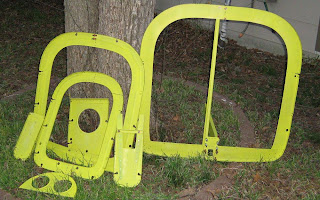I took most of the fiberglass parts inside to protect them from the heat. Here they are with the wingtips and some firewall forward parts. Also the rudder and elevator bottoms are just visible. The greenish colored parts came with the finishing kit- wheel pants, spinner, and empennage fairing.

I got started on the canopy frame yesterday. Installed the roll bar last week as a precursor to fitting the canopy frame. The canopy process has been cited as the most difficult building step by many RVers. I've taken this to heart, and am moving very slowly, double and triple-checking measurements and plans before doing anything permanent. I haven't riveted the front fuselage parts in place yet since I wanted to get started on the canopy while it's still warm. The plexiglass canopy is more forgiving when it's warm.
 Another view of the canopy frame. It's just setting in place, nothing has been drilled to the fuselage yet. The first steps are to bend the frame to fit the fuselage. It would appear at first blush that I've lucked out- the fit looks good. A little tweaking of the side rails, some adjustment at the rear and hopefully it's good to go... Wish me luck....
Another view of the canopy frame. It's just setting in place, nothing has been drilled to the fuselage yet. The first steps are to bend the frame to fit the fuselage. It would appear at first blush that I've lucked out- the fit looks good. A little tweaking of the side rails, some adjustment at the rear and hopefully it's good to go... Wish me luck....






















